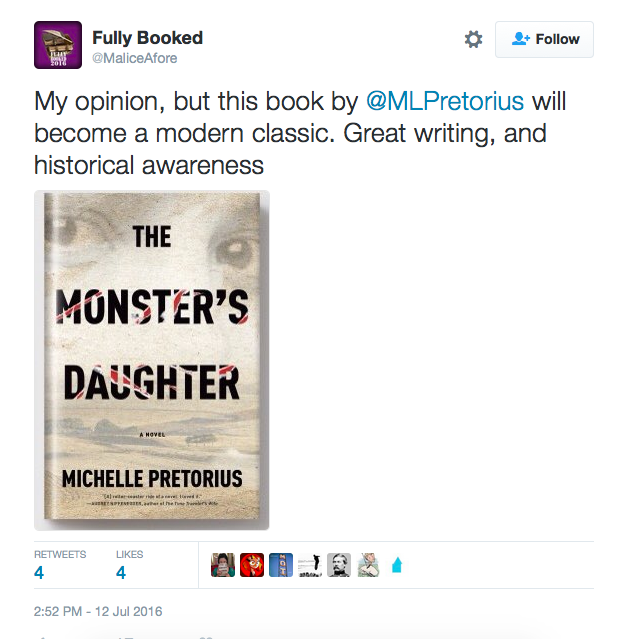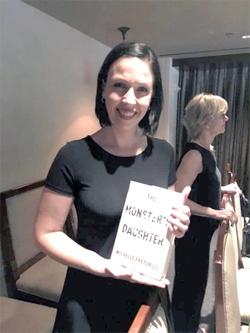
Michelle Pretorius
By Kristin M. Distel
Michelle Pretorius, doctoral student in creative writing, recently published her debut novel, The Monster’s Daughter. The novel—nearly a tome at 464 pages—was released July 19 by Melville House and Audible. Pretorius also published an essay, “Using the Lies of Fiction to Get to the Truth of Apartheid,” with Literary Hub. The essay coincides with the publication of The Monster’s Daughter.
Pretorius’s essay explores her upbringing in South Africa and the lingering, far-reaching consequences of apartheid.
“I grew up in apartheid-era South Africa, where people were categorized and oppressed according to skin color. White, black, and ‘colored’ (a racial classification for people of mixed heritage) all lived in separate areas, the borders strictly patrolled so that one color didn’t venture into the realm of another. Non-whites had to carry passes to work in white areas. Children often grew up without their parents because they could not accompany them to the cities. Whites also were prosecuted for miscegenation if they loved across the color line, even though the punishment was never as severe as for their black partners.”
The Monster’s Daughter takes as one of its two main characters Alet Berg, a female constable in the modern South African Police Force who finds herself in the midst of a murder mystery that spans multiple generations. Alet lives in the shadow of her father, Adriaan Berg, who was a powerful figure in the struggle between the government and the African National Congress. Tessa is the novel’s second female protagonist. Pretorius wanted her debut novel to feature a character who is “a witness to the whole history of apartheid.” Tessa fits the bill perfectly. The complexity of the characters’ respective histories propels the novel forward and piques readers’ curiosity.
“A Modern Classic”
The novel has already received excellent reviews and will soon be reviewed in The Times in the United Kingdom.
“Michelle Pretorius is a funny, surprising and fearless writer. The Monster’s Daughter is at once a historical thriller that reckons seriously with South African politics, an imaginative piece of speculative fiction, and a stereotype-busting roller-coaster ride of a novel. I loved it,” says Audrey Niffenegger, author of The Time Traveler’s Wife.
The novel is also being praised among social media users:

Pretorius’s novel is being praised on social media
The History of a Nation, the History of a Writer
The Monster’s Daughter is the product of five years of writing, research, and revision. Pretorius began the novel in 2010, when she was working on her Master of Fine Arts degree in fiction writing at Columbia College Chicago. During her first semester there, Pretorius took a research course and began to investigate the Boer War. Born and raised in South Africa, Pretorius was aware of the horrors of apartheid but, as a white person and a child, was insulated from its most severe dangers.
During apartheid, systemic violence and the division of people into racialized communities meant that the non-white population was forced to be a cheap labor force for whites and live in impoverished conditions. Pretorius notes that government censorship was rampant. Any media that subverted the government and Christian Nationalist ideology were banned. Books of art that contained nudity were prohibited, for example, and there was an attempt to ban The Beatles because they claimed they were “more popular than God.” This censorship, Pretorius explains, was meant to keep the population ignorant and subservient.

Michelle Pretorius at the Melville House Bookseller’s Dinner, where she holds the hardback copy of her debut novel for the first time
One form of oppression that especially prompted the people to rebel, Pretorius recalls, was a law that mandated all non-white education be conducted in Afrikaans. Native languages were barred in schools. This form of oppression was disturbingly reminiscent of racial prejudice in schools at the turn of the century, when Afrikaner children were forced by the British to speak English. If children were caught speaking Afrikaans in school, they were required to wear humiliating signs around their necks. Other aspects of historical tragedy and erasure were rampant. Pretorius was surprised to learn, she notes, that many people were unaware that concentration camps—predating those of World War II—existed in South Africa.
Through its gripping main character and attention to historical detail, the novel confronts readers with uncomfortable truths about prejudice and racial aggression. This approach, several reviewers note, is both daring and effective.
A Credible Account of a National Tragedy
“Suffice to say that Michelle Pretorius takes a breathtaking risk in her plot.… The tensions and contradictions of Modern South Africa are described in an unflinching fashion, but without preaching or moralizing. The account of the country’s troubled past is secure and convincing. It is barely credible that this is a debut novel. The writing is spectacularly good; compassionate, evocative of time and place and, above all, totally credible. It is this which makes the author’s gamble pay off—in brilliant fashion,” notes David Prestidge, author and editor of Fully Booked.
Pretorius recently published an essay in Lit Hub that explains the impetus behind the novel and the part she hopes the book will play in the restoration of national memory.
“Yes, the novel is a work of fiction. It uses genre conventions, narrative devices, and fantastical lies. But my hope is that, through these fictional lies, it might just begin to tell a complex truth.”
The Monster’s Daughter is currently available at Melville House’s website, Amazon, Barnes & Noble, Walmart, and independent bookstores.



















Comments